Officials are trying to calm citizens' fears about millions of tons of fly ash and other potential drinking water contaminants at the former power plant site in Lawrenceburg.
(Lawrenceburg, Ind.) - Roughly 75 citizens and local leaders packed into a room at Ivy Tech Community College in Lawrenceburg on Tuesday for a sometimes contentious meeting about a company’s work to clean up the former Tanners Creek Power Plant site.
Tanners Creek Development LLC is remediating the 725-acre site for potential redevelopment as a new inland port. In addition to demolishing the old power plant building, the business is also working toward capping and closing the fly ash containment areas at the property.
The 2 ½-hour meeting had representatives of Commercial Development Company, Inc., the parent company of Tanners Creek Development, share their plan to close one of the fly ash ponds at the site. A panel of Indiana Department of Environmental Management officials were also present for the meeting the agency requires as part of the ash pond closure process.
Concerns about the safety of Aurora Utilities and Lawrenceburg-Manchester-Sparta Conservancy District drinking water wellheads reached a fever pitch last week on social media. Lawrenceburg Mayor Kelly Mollaun’s administration used Tuesday’s public meeting as an attempt to assuage some of those fears.
“We want you to hear from the experts,” city attorney Del Weldon said at the start of the meeting as he served as moderator. “We want you to hear from the people that are tasked by the state government, the federal government, to make sure that the environment is safe.”
Weldon acted as a moderator of the microphone during the meeting, allowing citizens to ask questions prior to the designated Q & A period toward the end of the meeting.
Tanners Creek Development Details Fly Ash Pond Closure Plan
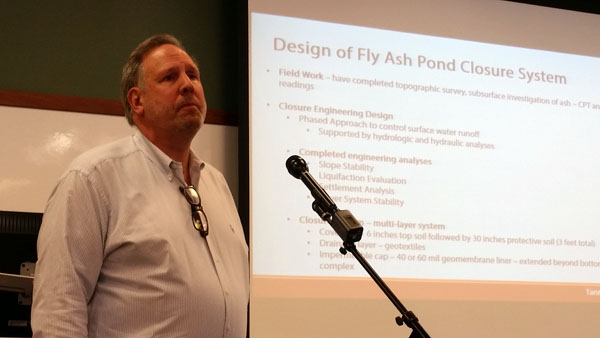
EnviroAnalyitcs Group president Russell Becker listens to a question during his presentation about the closure of the fly ash pond. Photo by Mike Perleberg, Eagle Country 99.3.
Millions of tons of fly ash are buried at the site from more than 60 years of American Electric Power operating the Tanners Creek Power Plant. Fly ash is the residual of coal burned off to power the plant’s electric generating units. It can contain environmentally harmful material including arsenic, lead, boron, mercury, and several other metals.
Russell Becker is president of EnviroAnalytics Group, an affiliate of Tanners Creek Development. He shared the company’s plan for closing the fly ash pond built on the western end of the power plant property.
Becker explained the fly ash pond started by AEP in the 1970s has a 20 mill PVC liner beneath it. The liner’s presence is unusual for such an old ash pond, considering liners were not required at the time filling started by AEP.
Capping the fly ash pond will be done with a multi-layered topping including, from top to bottom, six inches of cover soil with vegetation, a 30-inch protective soil layer with dirt borrowed from on-site, a geotextile drainage layer designed to move water out from the liner), and an impermeable 40 or 60 mill geomembrane liner.
Adam Peetz, Tanners Creek project manager for EAG, said the liner material is similar to what is used for trash bags, but it is much thicker.
“It will last for thousands of years in the condition which it is installed,” Peetz said.
The liner would be tied into existing liners on the sides and beneath the fly ash pond, essentially encapsulating the ash from rainwater or from leaching into the groundwater.
Fluctuating levels of the underground aquifer which runs beneath the ash pond would not disturb the ash, which rests about 20 feet above the 100 year floodplain, Becker explained.
Once the ash pond is capped, Tanners Creek Development will continue to meet IDEM-required obligations for 30 years, including inspections, maintenance, security, and post closure care.
Ongoing groundwater monitoring will include semiannual sampling and analyses of water from 20 monitoring wells surrounding the ash pond. The monitoring wells are the early warning system of any potential contamination leaking from the pond before it reaches the drinking water supply a half-mile away.
The company will pay for all that.
There are a handful of other ash containment areas at Tanners Creek. They include the main ash pond, old ash pond, an ash landfill, and a boiler slag area. Closure plans for those areas are being designed now through 2020. Those closure plans will go through a similar approval process with IDEM.
“Portions of this 700 acres all are part of our ongoing environmental obligations to work through, if you will, the closure process to remediate those sites and make them accessible and in shape for redevelopment,” said Becker.
A public comment period for the fly ash pond closure plan opened Tuesday and will remain open through July 10. Comments should be emailed to jhale@idem.in.gov. Additionally, comments may be mailed to John Hale, Permit Manager, Indiana Department of Environmental Management, Solid Waste Permits, IGCN 1101, 100 North Senate Avenue, Indianapolis, IN 46204.
IDEM involved in monitoring the site
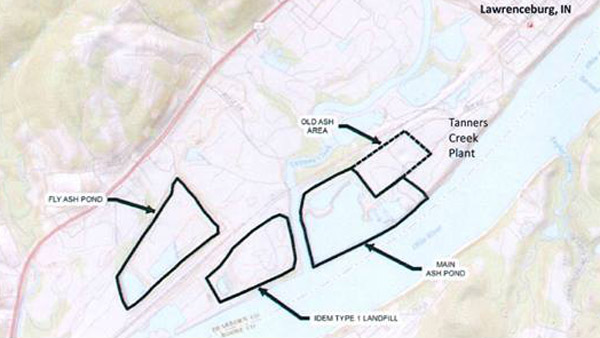
A map of the ash pond complex at the former Tanners Creek Power Plant site in Lawrenceburg, Indiana. The labeled "fly ash pond" complex located furthest west was the subject of Tuesday's ash pond closure meeting. Image by Tanners Creek Development LLC.
“We’ve been looking at the proximity of the drinking water supply wells. It’s reasonable, very reasonable, to ask questions and be concerned about that. We’re concerned about that as well,” said Rebecca Joniskan, chief of the permits branch for IDEM’s Office of Land Quality.
Joniskan said IDEM has been working with Tanners Creek Development since they purchased the power plant property from AEP in 2016. The fly ash pond and other ash disposal sites will have groundwater monitoring wells added. In the case of existing monitoring wells, baseline water testing has already been performed.
Part of the closure plan approval process will include the addition of monitoring wells and detecting any releases from the ash pond, she added. IDEM has high standards, rules, and regulations to protect Indiana’s environment.
Weldon asked if material from the concrete smokestacks demolished earlier this year is tested for contamination. Tanners Creek Development has been using concrete and brick from the power plant demolition as fill material around the site, another practice which has produced worries about groundwater contamination.
Joniskan said IDEM’s permits to Tanners Creek Development are only for ash areas, meaning there is no ongoing monitoring of activities at other sections of the site. “Clean demolition debris,” she said, is not considered solid waste in Indiana and can be disposed of most anywhere if it is clean.
Becker said demolition processes by their very nature generate clean debris and concrete. The company has tried to reuse as much as possible for backfill for the power plant’s old basement and other structures. He likened the clean debris to soil – concrete is rock and old brick is essentially mud.
As far as contamination from the use of debris as fill, Becker said all hazardous material was removed from the plant prior to the demolition. That included asbestos mediation in the plant building, which was inspected monthly by IDEM with no violations prior to being razed, according to Becker.
Lawrenceburg Municipal Utilities director scolds “fearmongering” social media posts
Greendale resident and chemist Matt Miles last month began accusing local city and county leaders of not acting with enough urgency to combat what he perceived as improper remediation at the Tanners Creek site.
Although Miles’ posts on a Facebook page titled "Protect the Water Dearborn County" have helped to make more citizens aware of the fly ash’s potential impact on local drinking water, he has also shared information others believe is wrong and inflammatory.
In an interview with Fox 19 last week, he claimed that Dearborn County could become the next Flint, Michigan water crisis.
Lawrenceburg Municipal Utilities director Olin Clawson not so subtly referenced Milles, who was present at Tuesday’s meeting, as a fearmonger.
“When I have elderly customers calling me and telling me they are afraid to take baths because of the posts they are reading on Facebook, and the other people in their apartment complex are going out and buying bottled water because of what they read on Facebook, that is concerning to me. That is a form of fearmongering that I don’t appreciate and I don’t think is helpful to this process,” Clawson said.
Clawson stressed that citizens should know that no one is more concerned with quality of the water sent to customers as the utility companies.
LMU has conducted extra testing of water in Lawrenceburg, Aurora, and LMS wells. There are higher than normal levels of boron found in the local water at 1,000 parts per billion. Although IDEM does not set a maximum contaminant level for boron in drinking water, the World Health Organization suggests a health-based guideline of 2,400 parts per billion.
Jim Sullivan, chief of IDEM’s Office of Water Quality Ground Water Section Drinking Water Branch, said quality of drinking water is taken seriously under the federal Safe Drinking Water Act. He credited the local utilities for a good job monitoring their water source.
Citizens pose their questions
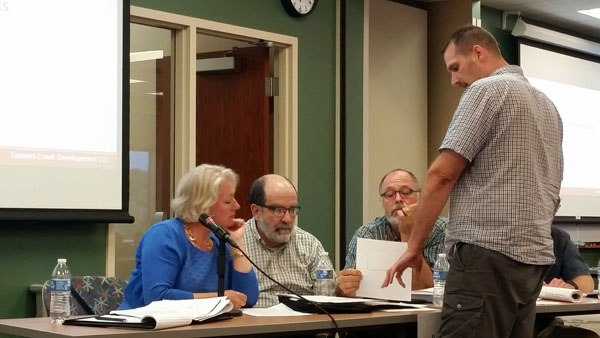
Matt Miles (standing) shows a panel of Indiana Department of Environmental Management officials his documentation concerning the fly ash pond at the former Tanners Creek Power Plant site in Lawrenceburg. Photo by Mike Perleberg, Eagle Country 99.3.
Several citizens among the dozens in attendance asked questions throughout the Tanners Creek Development and IDEM presentations, as well as during a public comment period near the end of the meeting.
Matt Miles was allowed to question the panel both inside and outside of the public Q & A time. He pressed CDC, IDEM, and local officials on whose responsibility is it to address any potential leaks in the lined ash pond. He said he has been attempted to alert local officials and IDEM to potential contamination problems at the site over the past few months.
“In fact, I just had Olin Clawson get up and basically get up and basically call me a fearmonger for saying that. As you are saying, it is not your responsibility. Local officials are saying it is not their responsibility. Everyone is saying it is not their responsibility and actually accusing me of making it up. So I would like to find out whose responsibility is it?” Miles asked.
Weldon called it a fair question. IDEM invited Miles to share his data, which he did. He contends that contaminant levels of lead are already above drinking water standards.
IDEM Geology Section Chief John Guerrettaz added contaminants in the water are not being read at actionable levels. More groundwater monitoring wells will be established around the ash pond.
“If they have problems, it will be our responsibility to deal with that issue,” Guerrettaz said. “We will come up with a solution and fix it.”
Peetz said the local water is perfectly safe to drink and, once capped, the fly ash containment areas will have further protections to ensure it remains that way.
Earlier in the meeting, Miles differed with Becker on the makeup of the dikes surrounding the ash pond. He also said the monitoring wells are located too close to the ash pond complex and was critical that a third party is not used for water testing.
Peetz countered that water analyses is done by an independent lab, a service EAG pays for. Monitoring well testing is done by both EAG and the previous owner, AEP, with results reported to the state. The fact that no violations have been shown in the water testing should be reassuring the citizens.
“It is showing you that the water is being protected. It’s a good thing,” Peetz said.

Lawrenceburg city attorney Del Weldon moderated the town hall meeting held at Ivy Tech Community College. Photo by Mike Perleberg, Eagle Country 99.3.
Bright resident Brian DeBruler said he and friends attending the meeting were not aware the meeting was to be focused on the fly ash pond closure. They have been concerned with what is being done across the larger site.
He had several questions and took to the podium at multiple instances to ask them. He asked if a violation was issued to Tanners Creek Development for an April 12 fugitive dust cloud issue in Lawrenceburg. A dust cloud of what was presumably fly ash was seen emerging from the ash pond and blowing across Lawrenceburg.
“I refer to it as the dust bowl incident,” DeBruler said.
Joniskan did not know if a violation was issued. Weldon answered, saying that a warning was given to Tanners Creek Development following the episode. Both DeBruler and Weldon said they filed complaints about the fugitive ash.
According to filings by IDEM inspectors, the company’s water truck broke down that day, allowing the fly ash on the surface to dry out and go airborne in strong winds.
Weldon said Mayor Kelly Mollaun and city safety director Mike Abdon went on site, contacted IDEM, and spoke with Tanners Creek Development employees about the dust. The warning, he added, included requirements that the company have a better dust suppression plan in place.
DeBruler said there were multiple other fugitive ash incidents around April 12 which were not documented by IDEM.
Peetz chimed in that capping and closing the fly ash pond will eliminate such occurrences in the future.
DeBruler later asked if the site has ever been tested for radioactivity. He referenced findings at other ash containment sites in Indiana. Radium can come from the coal combustion residual ash. Guerrettaz said radioactivity is not a part of typical waste testing, but groundwater testing would detect that. Clawson confirmed that LMU does test for radium.
Chris Mueller asked what will happen if contaminants ever reach an actionable level. Guerrettaz said a common way to treat such a problem is to pump and treat water from around the fly ash pond. In the Lawrenceburg case, Tanners Creek Development LLC would pay for that corrective action and be responsible for supplying safe drinking water, if need be.
Peetz said there is a “required financial assurance mechanism” to ensure problems are taken care of.
Pam Rigacci posed questions about demolition debris from the old power plant building being used as fill on the site. Becker said only clean material is reused on the site. Other debris, such as metal, was recycled.
Joniskan surmised that any contamination at the power plant building site on the east end of the property would likely never reach the Aurora and LMS wellheads due to the distance and the presence of Tanners Creek between the two areas.
She said IDEM’s solid waste compliance inspectors would investigate any complaints about demo materials not being managed appropriately.
“Anytime you see something, say something,” added Weldon. “We have never reached out to IDEM and been met with anything other than everything being taken very seriously and taking action.”
Aurora Utilities superintendent Randy Turner spoke from the audience toward the end of the meeting. He said the utility’s monitoring of the water quality, which has found safe levels of boron, will continue.
He said all the attention being given to the area’s water is good. He thanked all those who have weighed in on the matter.
“This water is one of the best assets of our area. This is the kind of attention something like this needs,” he said to applause.
Turner said if the local groundwater ever becomes unusable, the Ohio River is right there. He pointed to Greater Cincinnati Water Works, which treats water from the river to supply drinking water to hundreds of thousands of residents.
“This doesn’t end here. We will continue to protect our water,” Weldon concluded the meeting.
RELATED STORIES:
Fly Ash Pond Closure Plan Is Subject Of Public Meeting Tuesday
After Out-Of-State Fly Ash Halted, Questions Over What's Already In The Ground At Tanners Creek
Doesn't Look Like Company Will Appeal Denial Of Lawrenceburg Fly Ash Permit
Dearborn Co. Commissioners Ban Out-Of-State Fly Ash, At Least For Filling
County Commissioners Table Fly Ash Ordinance; Scientist Says Measure Could Trigger Litigation
Citizens Air Worries About Fly Ash Shipped Into Lawrenceburg
IDEM Opens Fly Ash Permit Modification For Public Comment
County Commissioners Join Lawrenceburg In Effort To Block Out-Of-State Fly Ash
Could Ordinance Stop Fly Ash From Being Shipped Into Lawrenceburg?
AUDIO: Water Utilities, State Lawmaker Are Latest To Oppose Fly Ash Shipments
Toxic Fly Ash Could Be Shipped Into Lawrenceburg; Mayor Trying To Make A Stand

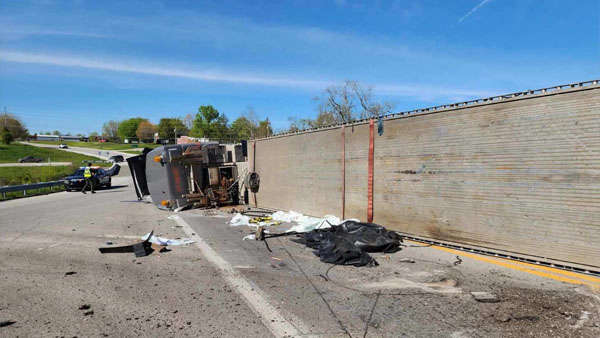 Multiple Agencies Respond to Semi Rollover in Versailles
Multiple Agencies Respond to Semi Rollover in Versailles
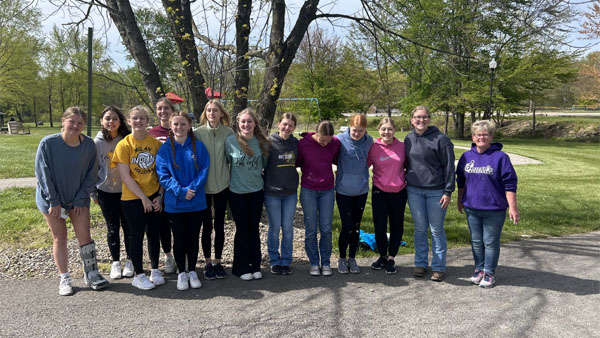 Milan High School Hosts Best Effort Day
Milan High School Hosts Best Effort Day
 Aurora Announces Citywide Cleanup
Aurora Announces Citywide Cleanup
 Opening of St. Elizabeth Dearborn Cancer Center Brings Comprehensive Cancer Care to SEI
Opening of St. Elizabeth Dearborn Cancer Center Brings Comprehensive Cancer Care to SEI
 First Early-Voting Saturday Set for this Weekend in Dearborn County
First Early-Voting Saturday Set for this Weekend in Dearborn County
 South Ripley High School Triumphs in Indiana Army National Guard Enlistment Challenge
South Ripley High School Triumphs in Indiana Army National Guard Enlistment Challenge











